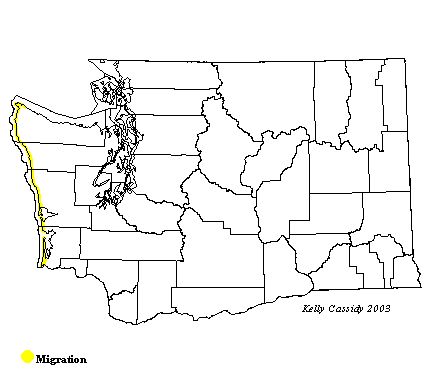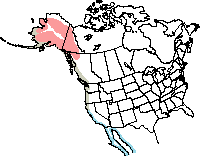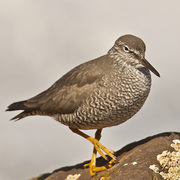Wandering Tattler
General Description
The Wandering Tattler is the only shorebird in this region that is plain gray above and heavily barred below. Its bill is of medium length for a shorebird, and it has short, yellow legs. Wandering Tattlers seen in Washington are typically in breeding plumage. Juveniles and adults in non-breeding plumage look similar to adults, but lack the barring below. In flight, the Wandering Tattler appears entirely gray above, with a solid gray tail and gray wings.
Habitat
Wandering Tattlers nest in the far north by rocky mountain streams. During migration and winter, they inhabit rocky coasts, reefs, jetties, and breakwaters.
Behavior
Wandering Tattlers are basically solitary birds, on the ground and especially in flight. They bob and teeter while feeding, and move nervously and quickly over rocks, probing for active prey on the surface. On the breeding grounds, they walk or wade along streams to find food. The Wandering Tattler gets part of its name from its practice of giving alarm calls when perceived threats are nearby, alerting other shorebirds to the danger. Its call is a series of clear, hollow whistles, all on one pitch.
Diet
Wandering Tattlers eat insects, crustaceans, worms, and small animals that scramble among the rocks.
Nesting
The nest of the Wandering Tattler is located on the ground in a hollow in rocks or gravel, usually near a stream. It is a shallow depression that may or may not be lined with small twigs, rootlets, or leaves. Both parents help incubate the 4 eggs for 23-25 days. Once hatched, the young leave the nest within a day and can feed themselves immediately. Both parents tend the young, although within a week or two, one parent leaves. The remaining parent tends the young until they are independent.
Migration Status
Long-distance migrants, Wandering Tattlers travel from Alaska and northwest Canada to the southern California coast and beyond, with some birds crossing the Pacific Ocean to spend the winter in Australia and on islands in the South Pacific.
Conservation Status
The Canadian Wildlife Service estimates the population of Wandering Tattlers to number 10,000 birds, with half of that number breeding in Canada. They are widely dispersed across their breeding and wintering range. This distribution makes the population difficult to survey, but probably also helps their numbers to remain stable.
When and Where to Find in Washington
Wandering Tattlers are common migrants on the coast of Washington. They are rare in Puget Sound and other parts of Washington. In the spring, they are common from mid-April to mid-May. They are usually gone from the Washington coast by the second week of May. The post-breeding migration is more protracted, with adults common on Washington's rocky outer coast from mid-July into August. By the second week of August, most of the Wandering Tattlers coming through are juveniles, and are common into October.
 Abundance
Abundance
| Ecoregion | Jan | Feb | Mar | Apr | May | Jun | Jul | Aug | Sep | Oct | Nov | Dec |
|---|---|---|---|---|---|---|---|---|---|---|---|---|
| Oceanic | ||||||||||||
| Pacific Northwest Coast | F | F | F | F | F | R | ||||||
| Puget Trough | ||||||||||||
| North Cascades | ||||||||||||
| West Cascades | ||||||||||||
| East Cascades | ||||||||||||
| Okanogan | ||||||||||||
| Canadian Rockies | ||||||||||||
| Blue Mountains | ||||||||||||
| Columbia Plateau |
Washington Range Map

North American Range Map


Family Members
 Spotted SandpiperActitis macularius
Spotted SandpiperActitis macularius Solitary SandpiperTringa solitaria
Solitary SandpiperTringa solitaria Gray-tailed TattlerTringa brevipes
Gray-tailed TattlerTringa brevipes Wandering TattlerTringa incana
Wandering TattlerTringa incana Greater YellowlegsTringa melanoleuca
Greater YellowlegsTringa melanoleuca WilletTringa semipalmata
WilletTringa semipalmata Lesser YellowlegsTringa flavipes
Lesser YellowlegsTringa flavipes Upland SandpiperBartramia longicauda
Upland SandpiperBartramia longicauda Little CurlewNumenius minutus
Little CurlewNumenius minutus WhimbrelNumenius phaeopus
WhimbrelNumenius phaeopus Bristle-thighed CurlewNumenius tahitiensis
Bristle-thighed CurlewNumenius tahitiensis Long-billed CurlewNumenius americanus
Long-billed CurlewNumenius americanus Hudsonian GodwitLimosa haemastica
Hudsonian GodwitLimosa haemastica Bar-tailed GodwitLimosa lapponica
Bar-tailed GodwitLimosa lapponica Marbled GodwitLimosa fedoa
Marbled GodwitLimosa fedoa Ruddy TurnstoneArenaria interpres
Ruddy TurnstoneArenaria interpres Black TurnstoneArenaria melanocephala
Black TurnstoneArenaria melanocephala SurfbirdAphriza virgata
SurfbirdAphriza virgata Great KnotCalidris tenuirostris
Great KnotCalidris tenuirostris Red KnotCalidris canutus
Red KnotCalidris canutus SanderlingCalidris alba
SanderlingCalidris alba Semipalmated SandpiperCalidris pusilla
Semipalmated SandpiperCalidris pusilla Western SandpiperCalidris mauri
Western SandpiperCalidris mauri Red-necked StintCalidris ruficollis
Red-necked StintCalidris ruficollis Little StintCalidris minuta
Little StintCalidris minuta Temminck's StintCalidris temminckii
Temminck's StintCalidris temminckii Least SandpiperCalidris minutilla
Least SandpiperCalidris minutilla White-rumped SandpiperCalidris fuscicollis
White-rumped SandpiperCalidris fuscicollis Baird's SandpiperCalidris bairdii
Baird's SandpiperCalidris bairdii Pectoral SandpiperCalidris melanotos
Pectoral SandpiperCalidris melanotos Sharp-tailed SandpiperCalidris acuminata
Sharp-tailed SandpiperCalidris acuminata Rock SandpiperCalidris ptilocnemis
Rock SandpiperCalidris ptilocnemis DunlinCalidris alpina
DunlinCalidris alpina Curlew SandpiperCalidris ferruginea
Curlew SandpiperCalidris ferruginea Stilt SandpiperCalidris himantopus
Stilt SandpiperCalidris himantopus Buff-breasted SandpiperTryngites subruficollis
Buff-breasted SandpiperTryngites subruficollis RuffPhilomachus pugnax
RuffPhilomachus pugnax Short-billed DowitcherLimnodromus griseus
Short-billed DowitcherLimnodromus griseus Long-billed DowitcherLimnodromus scolopaceus
Long-billed DowitcherLimnodromus scolopaceus Jack SnipeLymnocryptes minimus
Jack SnipeLymnocryptes minimus Wilson's SnipeGallinago delicata
Wilson's SnipeGallinago delicata Wilson's PhalaropePhalaropus tricolor
Wilson's PhalaropePhalaropus tricolor Red-necked PhalaropePhalaropus lobatus
Red-necked PhalaropePhalaropus lobatus Red PhalaropePhalaropus fulicarius
Red PhalaropePhalaropus fulicarius

